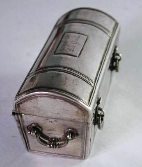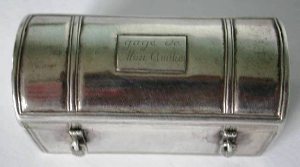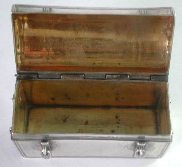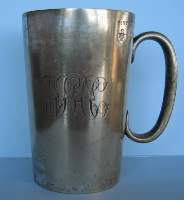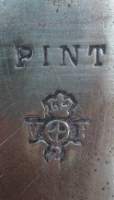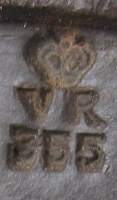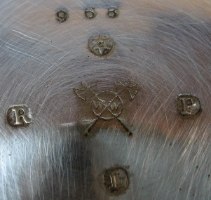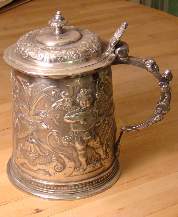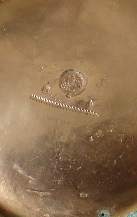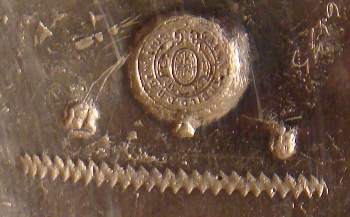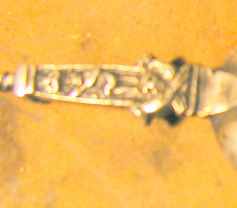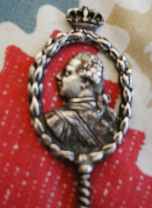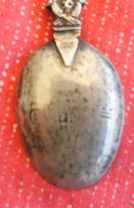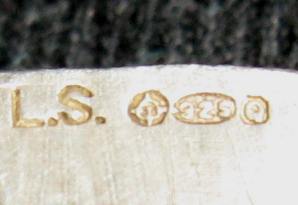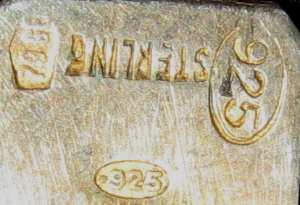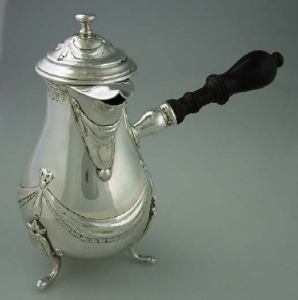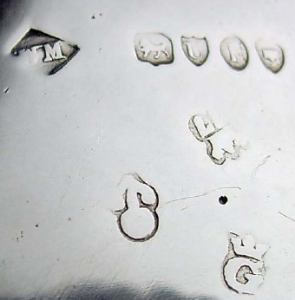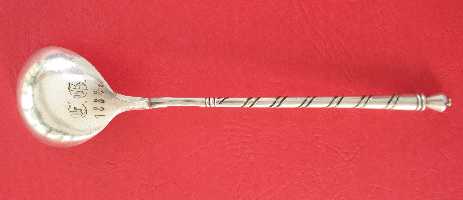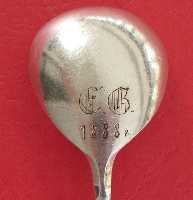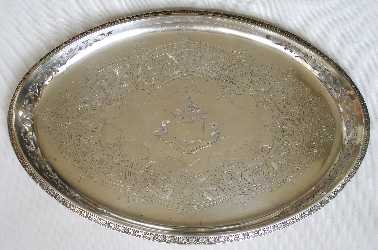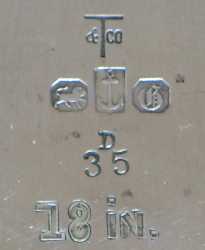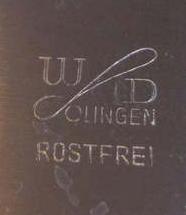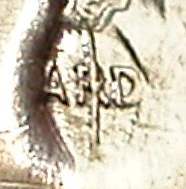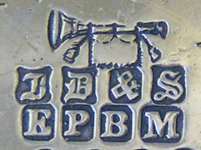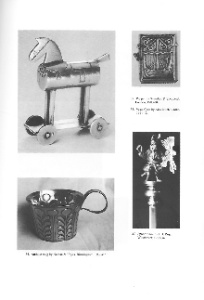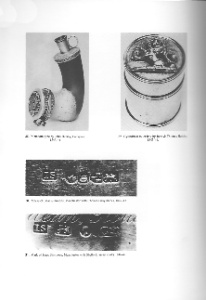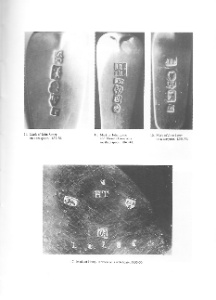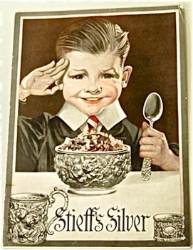
Scott Perkins presents:
The Stieff Company: Historic overview 
.....The Baltimore Sterling Silver Manufacturing Company
was started in 1892 by Charles Clinton Stieff and
several partners. Mr. Stieff was not a silversmith
himself, but an entrepreneur who dealt in silver and
cutlery. The first pattern for the new company was
Maryland Rose. Other early silver patterns were
Victoria, Plain & Engraved and Chrysanthemum. (The names
of Rose and Maryland Rose were alternated by the company
through the 1920's).
In the early years, the company would make silver for
both its own retail shop located at 17 North Liberty
Street in downtown Baltimore, and for other retailers
whose name would be stamped on the silver. This was an
early form of what we could today call "private label"
branding....
click here 
|
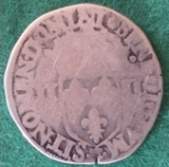
David McKinley presents:
The Britannia Standard for Wrought Plate 
.....In the absence of any documentary evidence
published by the government of the day the reasons for
the introduction of The New Sterling Standard, now known
as "The Britannia Standard", for wrought plate on 25th
March 1697, apparently without reference to its
suitability as a medium in which silversmiths could
work, remains enigmatic. Equally mystifying is that a
short twenty three years later the then government found
it perfectly acceptable to re-introduce the sterling
standard.....
click here 
|
Welcome to new ASCAS members:
Andrew Brown - Australia
Neil Craig - England UK
Jayshree Desai - USA
Ghulam Nabi - Pakistan
Anang Naik - Austria
Barry Phelps - England UK
Murray Stewart - Australia
Maureen Wickham - Canada
Members' Window # 76
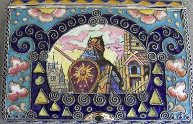
Postnikov presents:
The Russian cigarette case - from Fabergé to GULAG 
When, after the Crimean War (1853 - 1856), cigarette
smoking became more and more fashionable (previously
tobacco was only chewed, snuffed and smoked in pipes or
cigars), the silver manufacturers began to switch their
production from snuff boxes to cigarette cases. They had
to insert into their new designs a space for the safety
match, the invention patented in 1852 by Swedish
engineer John Edvard Lundström and highly appreciated by
its users.....
click here 
|
Hymie Dinerstein writes:
...I attach photos of a silver box in the form of a trunk which
measures 67mm long, 33mm wide, 36mm high and weighs 103 grams. I
believe it is German but cannot trace the mark in Rosenburg.
Can you help?
Thanks,
Hymie Dinerstein
Bruno Bruni writes:
... Recently I bought an English Victorian pint tankard with C
handle, marked to the left of the handle with Imperial capacity
mark PINT, which came into use with the weights and measures act
of 1 824, and with the cross in circle under crown and VR 2,
which is the Arms of the City of London, used as a verification
mark in the City of London until 1879.
Divisional marks for London city were used from the late
1830s which comprised a crowned circular version of the city
arms above "1" or "2". These continued to be used until 1879 (Marks
and markings of weight and measures of the British isles; Carl
Ricketts, 1996)
On the bottom various marks: 968, a six point star in a circle,
two crossed axes bound by a circle with W/ W, with R, P and L to
left, right and bottom, respectively. This mark belongs to
Robert Pringle.
The verification mark pre-1879 dates the tankard before the firm
became Robert Pringle & Co (1882).
Do you have any idea when could the tankard be manufactured?
Bruno Bruni
The firm continued to mark its sterling silver only with
"RP" also when was transformed in &Co and in & Sons (but I found
a silver plate piece marked & CO).
Your mark bears two letters "W" besides the crossed axes (not
present in later silver plate marks: see at
http://www.silvercollection.it/electroplatesilverNOPquattro.html
). The firm was active in Wilderness Row from some time
after 1863 (later the Street was renamed Clerkenwell Road).
Notwithstanding 'Culme' quotes "extensive addition and
alteration were made to the premises (subsequently known as
Wilderness Works)", the presence of the two "W" (for
Wilderness Works) and the old capacity mark (used until 1879)
suggests to date your piece between "some time after 1863" and
1879.
Giorgio Busetto
David Center writes:
...Here are some pictures of the spoon I am trying to research.
The only thing I have found out about it is it is French and
made just before the revolution.
That is if it is real and not a forgery what do you think?
Thank you very much for your help
David Center
In my opinion the origin of your spoon is not France but The
Netherlands, late 19th century.
Anyway I'll publish your question in September Newsletter. I
trust in the help of ASCAS members.
Giorgio Busetto
David McKinley writes:
...My ongoing research has brought to light information which
has encouraged me, for the sake of historical accuracy, to amend
my notes on "The Legal Position of The English Leopard".
The alteration does not in any way alter the gist of the piece
and you may not consider it worthwhile amending the entry on the
website but in case you do here is what I have done.....
David McKinley
Dear David,
The web has an advantage on the printed paper: to revise an
article is a simple and fast affair.
Click here to read the new sentence in your updated article.
Giorgio Busetto
Victoria Price writes:
...I have had a silver bracelet in my possession for about 10
years now. It was given to me by my mother, but as she is quite
poorly and has lost a lot of her memory, she can not tell me
anything about it.
I am not interested in selling it. I am a jewellery designer and
it has become an obsession of mine to fine out more about it. I
have taken some very clear pictures of the Bracelet and its
hallmarks
I'd be very grateful for any information you can supply
Thank you
Victoria Price
The bracelet was made in Italy in the 1950s. The maker is
identifiable by the mark inside the lozenge. I don’t read well
if the number is 78 GE or 79 GE (I believe it is 79).
Anyway if the mark is 78 GE the maker is L’Orafo di
Sansebastiano Luigi, Chiavari, (Genoa) while if the number is 79
GE the maker is Alioto Adriana, Genoa.
The bracelet bears also the UK import marks of London, date
1951. I’m unable to identify the importer’s mark (L.S.).
Giorgio Busetto
Patrick Street writes:
...I have a small chocolate pot which I am sure you will
identify because of the marks. It has the London import marks
for 1895. The mark 'WM' on the base of the small chocolate pot
belongs to William Moering, a Foreign Agent who registered his
mark at the London Assay Office in December 1882 and objects
have been seen with his mark between 1897 and 1902. It’s the
other marks I am interested in identifying.
At first I thought they may be French but on further reflection
I think they may be Belgian marks the crowned 77 being for 1777,
the crowned G for Ghent. Do you recognise the other mark of the
dot with the arrow above? Perhaps the maker’s mark? I would be
pleased if you could help me.
Many thanks for your kindness.
Best regards
Patrick
My knowledge of Belgian silver is modest and I'm unable to
identify the marks.
I trust in the help of members well acquainted with Flemish
silver for a quick identification.
Giorgio Busetto
I'm unable to identify the Town mark and, consequently, also
the identification of the maker and of the assayer is difficult.
Any suggestion will be welcome
Giorgio Busetto
Replies to questions
Les Salvage writes:
I believe it was Einstein who coined the phrase "A little
knowledge is a dangerous thing".
For myself, I am finding this very apt in the wonderful world of
silverware.
In trying to be helpful to Caroline, I submitted
(see May Newsletter) what I thought was a plausible
explanation of the marks on her tray. Unfortunately, I took the
D as being a date mark, and from there I misled myself on the
basis of other known but irrelevant information about Gorham. If
D is a date mark, then because Gorham started to use date marks
from 1868 starting with A, then D puts a date of 1871 on the
tray.
My article was pure hypothesis and I fully expected it to be
challenged but it seems to have been accepted.
The point is that, had D been a date mark, Gorham's marks should
have included 'Sterling' because it was from 1868 that Gorham
adopted the English standard of 0.925 fine for Sterling
silverware. It follows from this that a Gorham mark for solid
silver which does not include Sterling, must have been made
prior to 1868.
Having submitted my hypothesis, and knowing that it was utter
conjecture, I decided to investigate further. I have since read
GORHAM SILVER 1831-1981 by Charles H Carpenter Jr, and, together
with some information received from an American researcher of
Gorham, much of what I wrote in my May article can be dismissed
completely.
In fact the symbols D/35 indicate a special order for which a
cost slip should exist which may disclose the name represented
by the stylised T&Co and the date. It is not a practical
proposition to carry out a search in Gorham's archives due to
the immense nature of them, and by now, in any case, the cost
slip may have been lost.
This is not to say that Gorham did not make any sterling silver
before 1868, but when they did, Sterling would certainly have
been included in the mark. Indeed, I have seen photos of such
items.
To sum up, Caroline's tray seems to have been made before 1868,
is solid silver but is not Sterling. It must be of a standard
less than 0.925 fine and we may never know who is indicated by
T&Co.
My reference in my May article to the effect that the American
public may have believed Gorham's mark to be that of Birmingham,
England, stems from the fact that before the silver industry had
grown large in America, much of the silverware was imported from
England. I did not mean to imply that this was deliberate
deception.
If anyone can comment further on this question I should be very
pleased to hear it.
Les Salvage
Janjaap Luijt writes:
rostfrei = stainless
met vriendelijke groet,
Janjaap Luijt
Karin Sixl-Daniell writes:
Michelle Graham is looking for a flatware pattern by
Wilhelm Drache: It is called Amsterdam, available in stainless
steel and silverplate and can be seen on http://www.drache.net/bestecke.html
The background of the company's founder who died last year can
be retrieved at http://www.stiftungszentrum.de/willidrache/stifter.htm
(page in German).
I hope this helps.
Kind regrads
Karin
José Luis Muñoz writes:
The mark of Carolyn
case belongs to Crossard Joseph, Date D'Insculpation:
1900-1920,
Symboles: A R D J, une crosse d'évèque, Installé au
36 rue de Montmorency à Paris
José Luis
|
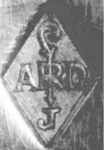
|
Robert Massart writes:
The mark Carolyn
Meacham is referring to, belongs to Crossard Joseph,
a manufacturer silversmith who was active in Paris
from 1900 till 1920 at 36 rue de Montmorency.
N° de garantie : C301
N° de préfecture: 11759
Symbol: a crosier (French : une crosse)
cross + ARD = Crossard!
Attacched 2 pictures of the same mark.
Kind regards,
Robert
|


|
Christophe Ginter writes:
The silversmith is
Joseph CROSSARD, Paris 1900-1920
The mark is a trick:
mixing a bishop "cross" (in French: crosse) and
adding ARD for representing his name.
There is a "J" at the bottom for figuring his
Christian name.
Best regards,
Christophe
|

|
Simon Buxton writes:
Regarding the marks on this fork, the UK RD number refers
to the registered design number and dates to 1949. The fork
could have been made at or any time after this date. This number
series began in 1884. You can find details at
http://www.oldcopper.org/registered_designs.htm including how to
assign an approximate year to the number.
It is not a patent number and indeed an ordinary fork is not a
novel invention so could never be the subject of a UK patent.
Thanks again for an interesting issue.
Regards
Simon
Thanks to Simon for correcting my mistake
Giorgio Busetto
In this column we present a page
obtained from makers' brochures, books, auction catalogs,
advertising or whatever other printed paper, related to silver,
that may be of interest for ASCAS members.
The images will be published at a "low resolution" level and for
private and personal use only
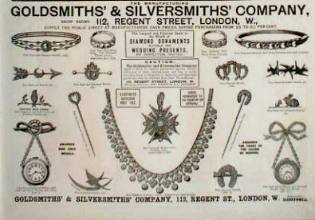
|
This month we present an ancient advertising of
GOLDSMITHS' & SILVERSMITHS' COMPANY
112 Regent Street London
A business of retail jewellers and silversmiths
established in 1880 in the premises previously managed
by Joseph Mechi.
The original partners were William Gibson and John
Lawrence Langman.
The firm was converted into an Ltd in 1898 under the
style Goldsmiths & Silversmiths Co Ltd. It was
amalgamated in 1952 with Garrard & Co Ltd.
|
"A WORD per MONTH"
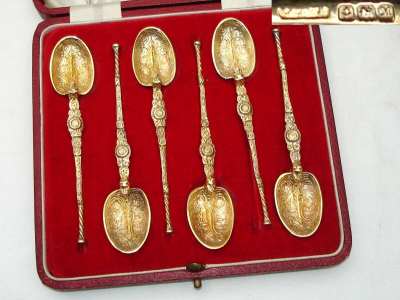
|
ANOINTING SPOON
ANOINTING SPOON REPLICAS
Authorities agree that the oldest silver spoon known to
be English in origin is the Coronation Spoon, preserved
among the Crown Jewels in the Tower of London, and that
it most probably has been used in Coronations of British
Monarchs since the 12th or early 13th Century.
It is made of silver gilt, and is the only remaining
piece of the original Royal Regalia. Some of the other
items of the Regalia were disposed off by Charles I, the
remainder were sold or melted down at the time of the
Commonwealth.....
more
|
"A SILVERSMITH per MONTH"
|
|
JAMES DIXON & SONS
The business of
manufacturing silversmiths, platers and Britannia metal
workers was commenced in c. 1806 by James Dixon in
conjunction with Thomas Smith in Silver Street,
Sheffield.
In 1824 they moved to Cornish Place, a large site, which
enabled them to expand and develop the workshops,
casting shops, offices and warehouses.
In 1823 Thomas Smith withdrew and William Frederick
Dixon, the eldest son of James, joined the firm. In
1830, the firm began making silver and plated goods at
Cornish Place by acquiring the firm Nicholson, Ashforth
and Cutts.....
more
|
"A BOOK ON MY SHELF"
In this column we present books, new
or ancient, dealing with silver in all its aspects (history,
marks, oddities...). This isn't a "book review" but only a fair
presentation of some useful "tools" that anyone may have in the
shelf of his bookcase.
ASCAS members are invited to contribute to this column
(click to enlarge images)
The "book on my shelf" of this month presents:
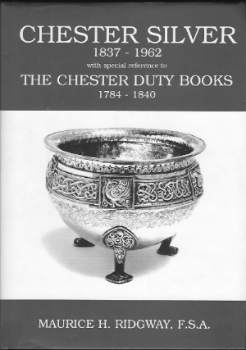
|
CHESTER SILVER
1837-1962
by
Maurice H. Ridgway, F.S.A.
Gee & Son (Denbigh) Ltd
Denbigh, 1996
Canon Maurice Ridgway ever since his
association with Sir Leonard Stone and the
publication of 'Chester Goldsmiths from early
times to 1726' (1968) followed by
'Chester Silver 1727-1837' has been
recognised as a leading authority on silver and
gold assayed in Chester.
This volume brings the record to the time of the
closure of the Assay Office. He also preserves
the interesting material found in the Chester
Duty Books from 1784-1840 and the continued
story of the Chester Goldsmiths Company to the
present day...
|
"A CREST per MONTH"
In this column we present images and
descriptions of Crests and Mottoes of British, Irish and
Scottish families as engraved on silver items.
ASH, ASHE, BAIRD, BOUCHERETT, BROOME, CURSON (possibly)
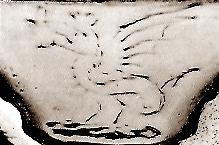
|
A cockatrice, crested and
armed (the cockatrice is a legendary creature,
resembling a large rooster with a lizard-like tail)
The crest was found in a silver salt marked by Anne
Tanqueray, London 1729
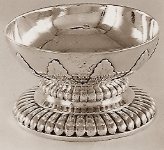
|
Closing our September 2010 edition of
ASCAS Newsletter I hope you have appreciated its content.
Your comments, suggestions and advice will be of great help.
My thanks to Peter Bower, Bruno
Bruni, Simon Buxton, David Center, Hymie Dinerstein, Jayne Dye,
Christophe Ginter, Janjaap Luijt, David McKinley, Robert Massart,
Claudio Morelli, José Luis Muñoz, Scott Perkins, Postnikov,
Victoria Price, Les Salvage, Karin Sixl-Daniell, Patrick Street
for their invaluable contributions.
Giorgio Busetto
Secretary
DISCLAIMER AND PRIVACY POLICY
ASCAS is a community of people having a common
interest in antique silver.
It is a non-profit association without commercial links.
Membership is open to whomever has a true interest in
this subject matter.
ASCAS has no real property and no fees are requested nor
accepted from members.
ASCAS keeps in touch with its members only through
periodical newsletters, e-mails and web-site updating
and ignores and is not responsible for any other
activity pursued by its members.
Likewise, ASCAS is not responsible for opinions,
evaluation and images displayed, and in any form
published or supplied for publication, by its members
who, in any case, maintain the property of their works
and assure the respect of national and international
legislation about Intellectual Property.
ASCAS does not have the full addresses of its members (only
town, country and e-mail address are requested for
membership).
ASCAS handles and protects with care its members' e-mail
addresses, will not disclose the addresses to third
parties, will use this information only to reply to
requests received from members and for communications
strictly related to its activity.
These rules are expressly accepted by submitting the
membership request.
|
|
 newsletter
# 76 September 2010
newsletter
# 76 September 2010







